-
Ricardo Benet: News from Afar (2004)
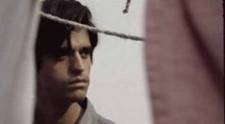
A spectral landscape and a splendid slow trip into time
Mexican Benet's awesome first feature News from Afar (Noticias lejanas) about people in a tiny settlement in the middle of nowhere and the young man who tries to escape marginality by leaving it, is a raw, real, disturbing journey in time as Argentinean Lisandro Alonso's Los Muertos is a journey through space, and both movies take us somewhere fraught with danger where we've never been before. Early on in News from Afar, we see Martín both as a little boy and as a tall, thin young man; we also see the little community celebrating with roasted geese they've bashed to death in a lagoon (and we've seen that too) and we see what we later learn is Martín's little brother Beto as a middle-aged man (José Juan de la O). Not Juanito -- the lost son: he died, and their mother (Mayahuel del Monte) was always sad after that.
The movie skips back and forth between past and present, so sure of itself, its locales so hot with rural Mexican reality (Benet has a wonderful eye and a way with actors) that everything flows naturally, if you sit back and let it, and thus the movie establishes a sense of the hostilities and pain that control the little family.
The women call each other "comadre" and the hamlet has no name. They just call it "17" from a milestone on the nearest road. It has a spectral emptiness, it is just a few cinder block houses and an auto parts graveyard and a brick factory, and it seems perpetually on the verge of drying up and vanishing, which eventually it does.
As it sporadically sketches in moments of time, the movie also sporadically lays out its beliefs, or its characters', at the beginning: we're born poor and we die poor; there is such a thing as luck but you must get up very early to find it.
A man and his family are visiting this place in a little car. And then he remembers and his voiceover takes us back and forth, till we leave him and enter into the world of his brother for a long time, and then the brother disappears into California ("the other side") and in time is lost.
That brother's story dominates the screen for a long while, but is only part of the story. The misery of the place, which is drying up, and the oppression of his step-father, the sadness of his mother and the guilt he feels, who knows why, for the death of Juanito cause Martín as a very young man to leave for "the city," that is, Mexico City, to find his father, make his fortune, and bring the others there. Before he goes his mother reaches into the tin box in her treasured wardrobe, her most valued possessions within her most valued object, and hands him a little scrap of paper with all she knows of his father, a phone number.
Martín's journey is difficult, as with all such journeys. A bridge is out and the bus can't go on and he walks with the half-dozen other passengers to a place called Pisarro where there's another bus that comes early in the morning. Or so they're told by a young man playing checkers with himself who's in charge of the place. He has a soft face and looks like Pasolini's actor Franco Citti, who always played degenerate, sensuous roles, and this guy acts like that, later on. They wait all night, the passengers, for the bus but when Martín awakes they're gone and they've stolen his possessions and he's alone. He must stay and work with the young man harvesting corn and hay in a ruined hacienda to make enough money to go on, but after the harvesting when they play like boys the young man, who is rumored to have killed his own parents to gain the hacienda for himself, is too friendly and Martín leaves very suddenly with the little money he's earned and some clothes the man gives him.
The actor David Aaron Estrada, who plays Martín, has a beautiful, long face with full lips and sad, limpid eyes. We see a lot of that face from now on and it takes on a hypnotic quality. Martín's time in Mexico City is not easy. He's homeless and penniless and spends times in the public flophouse where he's befriended by a bearded man, Don Erasmo (Francisco Beverido) and later he is helped by a waitress named Laura (Lucia Muñoz) who befriends him, but turns out to be stranger and needier than he can deal with. This segment of the film is very long, but it's only the beginning. Martín believes "you cannot change the future but you can the past" and an epigraph of the movie goes, "the hardest part of leaving….is coming back." The going back is shocking, but in the end it's a new beginning, and is where the family finally begins to escape from nowhere and wind up somewhere, even if some of them are lost.
Ricardo Benet's spare landscape marked by death, fire, madness and the wanderings of a young man is even more like the masterpieces of Cormac McCarthy (of the Border Trilogy and Blood Meridian) than The Three Burials of Melquiades Estrada, and it has some of the same harsh rural realism as Carlos Reygadas' Japón. News from Afar isn't for the impatient and may never reach audiences beyond the art house, but Benet is clearly another brilliant new Latin American director whose work will be sought out by connoisseurs of cinema: what he provides is simply a wonderful amalgam of intense emotion and unforgettable imagery. Like Alicia Scherson's Play, this is one of the SFIFF's narrative films that is clearly not to be missed.
SHOWTIMES
Tue, Apr 25 / 7:00 / PFA / NEWS25P
Sat, Apr 29 / 6:00 / Kabuki / NEWS29K
Tue, May 02 / 3:00 / Kabuki / NEWS02K
Last edited by Chris Knipp; 08-25-2014 at 11:43 PM.
-
SOME OTHER FESTIVAL FILMS, BRIEFLY NOTED
Daniel Yu: All About Love (2005).

Andy Lau as two characters with a doppelgänger with a goatee and pretty ladies Charlie Young and Charlene Choi and Amber. A man falls in love with a woman who turns out to have his dead wife's heart. Her estranged husband looks just like him, and that's because he's Andy Lau too. This contains lots of cute Hong Kong romantic gimmicks from movies and novels, including ones that Wong Kar-wai has often used in his rapturously stylized reworkings. Here the style is conventional and the thinking trite. The only interest is to see the technical displays, split-up editing, superabundance of flashbacks and computer manipulations, which are extremely slick, without making the material convincing -- though at times it's good for a laugh. This should not be in a film festival, but China film students/fans might want to watch it for its mastery of current clichés and tricks.
SHOWTIMES
Sun, Apr 23 / 4:30 / Kabuki / ALL23K
Wed, Apr 26 / 5:15 / Kabuki / ALL26K
Koji Wakamatsu: Cycling Chronicles: Landscapes the Boy Saw (2005).
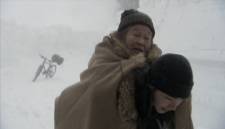
This by the pink film (pinku eiga) political radical softcore porn director of the past is a travelogue interspersed with dialogue and lovely images somewhat reminiscent of the "qatsi" trilogy of Godfrey Reggio. Chronicles follows a teenage boy on a bicycle through northern Japan in the wintertime. Wakamatsu gives away early on that the boy may have killed his mother and be running away (this is based on a true story of a boy who in fact did bludgeon his mother to death and then rode a bike in the north for sixteen days before he was apprehended).The young cyclist/actor Tasuku Emoto(who must have been chosen for his impressive level of endurance conditioning as well as for his striking, slightly savage face) is given no lines. He has one or two interesting encounters with people who deliver monologues pertaining to Japan in World War II. This feels like a narrative that wasn't developed enough or a short that was carried too far. It hovers between possibilities, leaving one with a haunted but empty feeling. Its inclusion in the SFIFF seems a somewhat dubious decision. It is an oddity. Even the most tirelsss cycling and landscape fans may not see the point of it.
SHOWTIMES
Thu, Apr 27 / 8:45 / Kabuki / CYCL27K
Tue, May 02 / 6:00 / Kabuki / CYCL02K
Kang Yi-Kwan: Sa-Kwa (2005)

A Korean relationship movie by a young director who lacks the sophisticated style of Hong Sang-soo. Fashion business lady Hyun-jung (Moon So-ri) is dumped by her seven-year boyfriend (Lee Seon-gyun) and quickly dates and marries office mate Sangkoon (Kim Tae-woo). He seems to bore her and goes south to work when she's pregnant; she periodically encounters the old boyfriend and toys with a reunion and divorce. Convincing acting by the lovely and soulful Moon So-ri and specific details about families don't quite save this picture from seeming bland and overlong; Kang's writing confuses subtlety with aimlessness. Marginally worth inclusion in a festival; there are livelier, more able Korean films out there, but Kang may still be one to watch.
SHOWTIMES
Fri, Apr 21 / 4:45 / Kabuki / SAKW21K
Mon, May 01 / 8:45 / Kabuki / SAKW01K
Thu, May 04 / 4:30 / Kabuki / SAKW04K
Last edited by Chris Knipp; 08-25-2014 at 11:48 PM.
-
WATCHING AND HELPING: TWO DOCUMENTARIES
Sacha Mirzoeff, Bettina Borgfeld: Shooting Under Fire (2005)

Shooting Under Fire follows experienced German photo-journalist Reinhard Kraus working as chief Reuters photographer in Israel in close coordination with his Palestinian and Israeli fellow Reuters photographers based respectively in Gaza and Jerusalem. Kraus came in to head the Jerusalem office with the second Intifada and left it for China after the death of Arafat, a little burnt out and stressed out but with a history of fine accomplishment behind him. The Palestinian-Israeli conflict remains a story without any foreseeable conclusion, but Kraus saw the end of a chapter, he feels. He also established an efficient working system for the Reuters photographers so that those who follow him can continue providing the same rapidly coordinated photo coverage of events and lives in this perpetually dangerous and unstable place.
Shooting Under Fire shows us some of the many striking images captured by the Reuters office during Kraus's watch, including award-winning photographs by Nir Elias of Israel and Palestinian Ahmed Jedullah, and we get a look at both men's lives and hear what they have to say about their countries and their work. Interestingly, Elias doesn't seem too happy with the new fences either, but he doesn't have to spend hours or days at Israeli checkpoints or stuck in Gaza because the gates are closed, as both Jedullah and Kraus did. The film is rich in coverage of coverage: it shows how a digital shoot of a suicide bombing is instantly edited and "moved" to the editors in Europe and it observes the photographers at first hand on location, reviewing a moment when Jedullah took a bullet in the leg shooting dead people on the road in Rafah and might have died, and taking time to show Elias shooting orthodox Jews at prayer. The documentary is narrated by the voices of Kraus, Jedullah, and Elias. There's not much new here for anyone who follows Middle Eastern news, but the film is visually fine and politically balanced -- to a fault when it cuts back and forth relentlessly between Jedullah worshiping with his son on Friday and Jews chanting at the Wailing Wall, as if more than five seconds of either would show bias.
This version made for National Geographic International.
SHOWTIMES
Sun, Apr 30 / 9:30 / Kabuki / SHOO30K
Thu, May 04 / 3:45 / Kabuki / SHOO04K
Adrian Belic: Beyond the Call (2006)
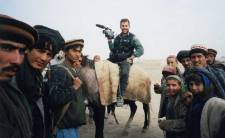
Adrian Belic's Beyond the Call's press material calls its subject a "Mother Teresa meets Indiana Jones adventure" involving "three senior citizens." Ed Artis, Walt Ratterman, and Jim Laws are in their fifties. They have no office, no overhead, and they take their aid, whether cash money or clothes, food, medicine, even a solar oven, direct to the "poorest of the poor" on the edge of war in Afghanistan, Albania, Chechnya, Cambodia, Rwanda and the southern Philippines -- parts of these countries other aids organizations, even the US army, can't reach or are afraid to go to. Two of them, Artis and Laws, are former paratroopers.
Artis' personality is feisty and his language salty. He has no use for politics or religion and he was a bad boy who joined the army to escape a longer time in juvie. His occasional illegal appropriation of things for humanitarian purposes makes him like a Robin Hood -- or a selfless Milo Minderbinder. His cohort Laws is a successful cardiologist and Ratterman is an oddball Pennsylvania construction company owner whose business used to gross $10 million. Now it's down to $2 million, he says, and that may drop to zero. The cardiologist is well off, the construction company owner borderline rich, but Artis, a retired mortgage banker, lives in a little house and has debts he puts off paying. All three men are hooked on doing good: it's a high, and you can feel that watching this film. The three men get in, find out what's most needed, then bring it, or come back later. They get an 80-90% discount on medicines. When they learned a little Afghan school had no money to pay the teachers, they paid out $2000 on the spot, enough for the staff for one year. Another time they handed over $31,000 out of wads of $100 bills for truckloads of food. Beyond the Call inspires admiration for this kind of selflessness and the hardscrabble efficiency of how the men, who call their group Knightsbridge because they're Knights of Malta forming a bridge to the world's most needy, get their aid out to people, despite risks of dysentery, death, kidnapping, and unpaid bills back home. By design, the three men's wives are unseen and undescribed. Clearly Knightsbridge does its own fundraising, but where all the money comes from is a detail the film leaves out, concentrating on breathlessly following the men to various countries and listening to their feisty, expletive-laced monologues.
Also at the Tribeca Film Festival. Adrian and his brother Roko grew up in Chicago with their Czechoslovakian and Yugoslavian parents. Their 1999 documentary Ghengis Blues, about a blind Cape Verdian bluesman from San Francisco who became a champion Tuval singer, won the Sundance Audience Award and was nominated for an Oscar for Best Feature Documentary.
SHOWTIMES
Sun, Apr 30 / 6:00 / Kabuki / BEYO30K
Thu, May 04 / 3:00 / Kabuki / BEYO04K
Last edited by Chris Knipp; 08-25-2014 at 11:57 PM.
-
Juan Diego Solanas: Northeast (Nordeste, 2005)
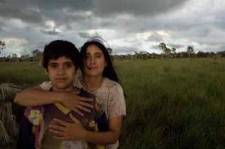
A terrible tale, left unresolved
Juan Diego Solanas begins his disturbing and frustrating film Northeast (Nordeste), which mixes cool aestheticism and harshly schematic realism, with the starkly filmed slaughter of a calf. When the carcass is hanging up a man cuts off a hunk of meat and gives it to a boy who takes it to his mother. The boy and his mother are 13-year-old Martín (Ignacio Ramon Jiméniz) and Juana (Aymará Rovera), who are handsome-looking but penniless and live in a hovel in the country somewhere -- we learn later -- in the far northeastern Formosa region of Argentina.
Meanwhile unmarried forty-something French pharmaceuticals executive Hélène (Carole Bouquet) travels to Buenas Aires to adopt a child -- an orphan, she hopes -- but quickly learns the arrangement she thought she'd made is nonexistent. Furious and needy, Hélène, who in Bouquet's troubling performance has a tragically naïve determination, flies north to Formosa where she hears opportunities for adoption are many.
Juana has a lover -- rather handsome too, but cold and harsh, a married ranch hand; it was he who gave Martín the meat. Hélène contacts young lawyer Gustavo (Juan Pablo Domench) who is inexperienced but knows enough to warn her what she wants to do means dealing with illegal child traffickers. Meanwhile the hitherto sweet and clean-cut young Martín, aware of the desperation at home, begins to cut school -- he lacks even the money for the bus ride there -- and falls in with ghetto boys who begin by stealing the buns he sells and then befriend him and show him how to sniff glue and shoot bottles with a pistol.
Hélène is lodged at a nearby ranch and drives back and forth in a truck. She gives Martín a ride and tries out her elementary Spanish on him and then on Juana. Juana is pregnant by her lover and uses dangerous anti-pregnancy drugs that cause hemorrhaging. She seeks help from Hélène, who she thinks is a doctor. Juana is served with an eviction notice and the rancher's agent is a crude squat bastard. ("Son of a whore" is a phrase frequently used in the film and seems to apply too well to many of the secondary characters.)
Gustavo takes Hélène to a midwife who gives them prices and tells them a blond baby costs more than an Indian. Hélène expresses indifference to color or price and is ready to go ahead. With the grim tone Solanas has set it's hardly unexpected that the process goes badly. When Hélène pays half the price as an advance, about $15,000, and is given an ominously quiet baby, one shrinks inwardly with the sure foreknowledge that the night she spends with it before its medical exam will only create a tragic attachment. Inevitably the doctor informs her that the baby has an incurable neurological disease and will not live. She freaks out and bolts screaming from the hospital leaving Gustavo and the baby behind.
A talk with a nun convinces Hélène buying an illegal baby is a selfish choice: the price would support many families, or sustain a child through college if he were allowed to stay at home. Hélène contritely returns to the midwife to take back the baby she was going to buy and care for it in France while it lives, but it is "gone," perhaps killed for the sale of its organs, who knows?
Juana's and Martín's conditions rapidly decline as Hélène reaches her own peak of desperation. A social worker, probably also involved in the omnipresent child trafficking in this desperate region, tells Juana social services do not exist to help her, that she should allow her son to be adopted so he can grow up in comfort and be educated abroad, and that she is selfish not to want to do so. The implication is obvious -- but not followed through in Solanas' film, which ends with Juana's cottage torched and her in the hospital. The camera slowly withdraws from Hélène and Martín sitting in the hospital corridor -- as if the filmmaker is turning away from the task of completing his somewhat crudely roughed in story.
Solanas is the son of Fernando Solanas, the renowned documentarian-activist of The Hour of the Furnaces and the current SFIFF's The Dignity of the Nobodies. But he has lived largely in France since he was young and this film has a style half European and half documentary. The use of non-actors for most of the cast -- except for the extremely experienced Bouquet, who's taken down a peg, however, by having to speak a great deal in clumsy Spanish -- is not entirely successful, and most of the characters, the lawyer, the child traffickers, the rancher's brutish agents, even Juana, her son, and her lover -- have little depth or originality in the depiction. Even Hélène is little but a cry of confused need. Juan Diego Solanas would seem to have inherited the social consciousness of his father without his warmth and faith in humanity. The resulting film is a succession of increasingly leaden scenes. The information Northeast conveys is important and tragic, but ultimately the film seems to acquire little life beyond its bald message of injustice and despair.
Solanas won the Cannes Best Short Film Jury Prize in 2003 for his previous work, The Man Without a Head. This first feature may be less successful but he has talent and ambition and is not going away.
SHOWTIMES
Sun, Apr 30 / 3:15 / Kabuki / NORT30K
Mon, May 01 / 9:00 / Kabuki / NORT01K
Wed, May 03 / 9:15 / Aquarius / NORT03A
Last edited by Chris Knipp; 08-25-2014 at 11:50 PM.
-
Roberto Gervitz: Underground Game (2005)

Spritz and fizzle
São Paulo, 21st century: a beautiful modern subway system haunted by Martín (Felipe Camargo), a sturdy man in a tweed jacket with a beard and bushy hair and a soft inquiring face. There's something both desolate and eager about him, mellow yet needy. We see him sometimes through a transparent subway map in a station as if this diagram is his future, his brain; he has a big paper version tacked on the wall of his cheap apartment. It's also his bible and his horoscope, the world of his dashed hopes. In his pocket is a little journal book with a marbleized cover where he jots down his random game plans. He follows women he sees in the subway cars. He gives them a name, and he bets on which stop they'll get off at and where they'll go from there. If their path corresponds to his pre-jotted pattern, maybe they're his Laura, his Beatrice. At night, he's a pianist who plays in a club wearing a satin-breasted jacket.
Director Gervitz based Jogo Subterrâneo on a Julio Cortázar story whose meandering lonely-guy plot he may have somewhat over-expanded; the premise is intriguing if ambiguous, but there is a loss of momentum in its development. To begin with, this Underground Game doesn't seem like one anyone can win. Gervitz was assisted by the likes of Jorge Duran though, the wordsmith who penned Pixote and Kiss of the Spider Woman, so you can't say the dialogue doesn't move. Pacing is very brisk and energetic at first, and we hold on for a good while before we start to lose some of our interest. The first half hour or so is an indeterminate but compulsively watchable chase seen through the nervous but unflagging camera of Lauro Escorel. Music intriguingly enters the mix, worked in through the pianist hero and a happy collaboration with Gervitz's best buddy composer Luiz Enrique Xavier. There's much to enjoy here, till Martín's pursuit leads to too many irrelevant details.
Others come and go, but three women emerge and linger through underground encounters. There's the sympathetic tattoo artist, Tania (Daniela Escobar) with her autistic daughter Victória (Thavyne Ferrari). There's a blind writer named Laura (Julia Lemmertz) whom Martín meets periodically -- in the subway, of course. She has her own game, eavesdropping on conversations and picking up ideas for her fiction. Martín confides in her -- elliptically. He violates his game to pursue a pale, heavily made up woman in red whom he follows outside the subway, even when she doesn't follow the outline he's sketched in his notebook. She's the confused and secretive Ana (Maria Luisa Mendonca) who Martín seems to sense is bad news, but keeps coming back to.
The trouble is it's hard to tell a minor character from a major one. Tania is nice and likes Martín, Laura is bright and stable. Why does our hero insist on pursuing the neurotic, affectless Ana? Some of the details of her life that finally emerge seem obtrusive, and in the way they're presented, they violate the previously exclusive focus on the hero's point of view. The feel-good ending may resolve some of our questions, but it looks awfully familiar. Too bad, because the film has an appealing look, pace, and sound and its hot/cold urban setting is a pleasant surprise coming from the land of boy gangsters and spider women.
Underground Game has shown at a number of film festivals (Bruges, San Sebastian, Palm Springs, Havana, DC) and now is at San Francisco's.
SHOWTIMES
Sun, Apr 30 / 9:15 / Kabuki / UNDE30K
Wed, May 03 / 6:00 / Kabuki / UNDE03K
Last edited by Chris Knipp; 05-11-2006 at 04:34 PM.
-
Philippe Faucon: The Betrayal (2005)

Betrayed by suspicion
This film about the Algerian war shown at the 2006 San Francisco International Film Festival was also currently on view in theaters in France. Director Faucon is a pied noir, born in Morocco in 1958 near the Algerian border. It may attract a US distributor but negative aspects would be the lack of a major star and the understatedness of the action. Based on Claude Sales' autobiographical account, The Betrayal/La trahison is rich in atmosphere with lots of authentic-looking Algerian faces, the omnipresent sound of Algerian Arabic. The film is the stark but convincing chronicle of a French army unit's day to day maneuvers as it crosses a patch of half deserted Algerian countryside in the summer of 1958 ferreting out fellaghas (FLN members). The unit leader is an idealistic, fair but psychically exhausted young lieutenant named Roque (Vincent Martinez)--who represents the author of the source book.
Four of the unit members are harkis, Algerian Arabs serving in the French Army, and it is their dilemma that is the real subject of the film. Roque considers them 100% French citizens, but he cannot guarantee their future or save them from the resentment of the locals who see them as traitors, from their fellow soldiers of white French origin who see them as wogs or from Roque's superiors who see them as saboteurs waiting for their moment to strike. Everyone, including Roque, is fed up with this conflict which has dragged on for so long. Meanwhile the unit is brutalizing locals, burning huts and resettling inhabitants in an increasingly rough manner; the harkis are stoned by Arab boys; and Algerian fellagha suspects are getting tortured and killed by other units or at headquarters.
It is a complex, no-win situation. The locals, afraid of French soldiers, are not talking. If their men are gone, they say they're off seeking work; the unit must assume they've joined the rebels. Some members of the unit are white pieds noirs, Frenchmen with colonial outlook born in the country with inbred prejudices against the Arabs. The four Arab members of the unit, led by Taieb (Ahmed Berrhama), are forced to act as the uneasy liaison between the army and the people. Pressure is on them to defect, as the war wears on they are losing their faith in the justice of the French side, and they necessarily keep to themselves, thus increasing the white French soldiers' suspicion or dislike.
Roque is called in to command and read to from a little notebook that clearly implies the four Arabs in the unit are double agents planning to kill the officers. We've seen no sign of that and neither has Roque, whose relationship with them has been good. The notebook could be a FLN plot to disrupt the unit. But in this volatile situation suspicion is almost as good as guilt. Perhaps the "betrayal" of the French is the hostile atmosphere they themselves have created. Or it is the failure of the harkis to become fully French. In any case, once this notebook emerges, Roque and his non-Arab cohorts can no longer be sure of the four Arab soldiers. Dialogue between the harkis themselves shows their growing discontent but is ambiguous as to their active disloyalty. Roque is curiously non-committal at the end, which seems abrupt and unsatisfying.
The film's strength -- its subtlety and its refusal to become a conventional thriller -- is also its weakness as drama, particularly for an American audience, which might find the meandering plot hard to follow or the concrete history, the realistic depiction of warfare at the village level, impossible to identify with.
This might best be seen together with another SFIFF (as well earlier Toronto Festival) film directly chronicling French history of the period, Alain Tasma's October 17, 1961, which concerns a later whitewashed Paris police massacre of 50 to 200 Algerians demonstrating against a curfew, denied medical care, thrown into the river, 10,000 arrested -- an event referred to in Michael Haneke's Caché.
SHOWTIMES
Fri, Apr 28 / 5:30 / Kabuki / BETR28K
Sun, Apr 30 / 6:30 / Kabuki / BETR30K
Wed, May 03 / 9:15 / PFA / BETR03P
Last edited by Chris Knipp; 05-11-2006 at 04:32 PM.
-
József Pacskovszky: See You in Space (Ég veled! 2005)

Getting spacey
Though unknown in the US, Hungarian director József Pacskovszky, whose new movie See You in Space (Ég veled!) was shown in the latter part of the San Francisco International Film Festival, 2006 version, has several previous features to his credit and an ample state-supported production behind this multi-romance movie (and multi-national production) with sci-fi and whimsical overtones. Moscow, Rome, Budapest and a space station orbiting the earth; Russian, Italian, Hungarian dialogue. Multinational cast, references to terrorism? Globalization, perhaps? You would think the forty-five-year-old Hungarian director is throwing too much into the multi-plotted soup, but he has a handsome visual style, nice music, and a pretty light touch to help compensate. This is no dark, brooding goulash. The only trouble is there doesn't seem to be much thought or wisdom invested in the stories, though the individual scenes are bright and colorful and well acted. If this is Kieslowski, as it seems at some moments, it's Kieslowski lite with a Fifties Tuscan accent. Here's what we're dealing with:
A Cosmonaut way out in space whose wife leaves him for an Italian illusionist, a handsome, charming philanderer (they speak Italian-- and there's some Italian production money in the film too, I think). The Cosmonaut and his handlers speak Russian, of course.
A wide-eyed male Budapest scientist who woos an African woman co-worker, a runner. Recovering from her sadness when she discovers by answering his cell phone that her boyfriend is married, the African lady tells her girlfriend a "funny" story about how she was sexually "touched" as a seven-year-old in Africa by a white man. They punished him. How? "We ate him." Perhaps strangely, this gets a laugh, and it's one of the movies' most memorable moments.
A dear, chubby old man with a lovely huge apartment and a nest egg who's befriended by a pretty young hairdresser after she accidentally cuts his ear. He might leave his money to her, but that event is short-circuited by events. This relationship is slight and sweet; the others are a bit more extended -- except for one between a woman lawyer who's increasingly gone on her imprisoned client, a story not very easy to follow or see the point of, though the lawyer happens to sit on a park bench next to the Cosmonaut's wife at one point, thus casually linking two of the stories.
Andrei, the formerly perky Cosmonaut, becomes despondent and refuses to come back to earth. In the festival Q & A the director said in fact the Russians left a Cosmonaut in space because they didn't have the money to retrieve him. By this he may have been conflating two factoids, that of Sergei Avdeyev, who spent a record time in space, and of the abandonment of the Mir Space station, where Avdeyev had been stationed. Anyway Andrei's wife gets wise to the Italian illusionist's unfaithful ways and decides to jump off one of the tallest old buildings in Budapest.
But when she jumps, she floats out in space and goes to the spaceship where Andrei is and knocks on the window. It's not likely he can let her in. . .
The scientist with the almost childlike eagerness and big eyes is the most striking figure in the piece. The others leave only a generic impression: the pert, independent African woman; the oily but sexy Italian; the loveable, corpulent old man.
The fanciful ending departs from Kieslowski and drifts back to Zavattini and Fellini and the Fifties. If the lady had just fallen off the building and died on the pavement the movie would have had an ending at once more acid and more tidy, but Pacskovszky would rather dabble than delve.
Last edited by Chris Knipp; 05-15-2006 at 12:30 AM.
-
COMING: Reviews of Ying Liang's Taking Father Home, Pascale Breton's Illumination, the SFIFF coming-of-age shorts series, Live 'n' Learn. and the Werner Herzog special event with his new movie, The Wild Blue Yonder.
These will posted separately on the Festivals site by TRAVIS KIRBY, a 15-year-old aspiring filmmaker and writer from the Bay Area who is my co-reviewer of the SFIFF for Filmleaf this year.
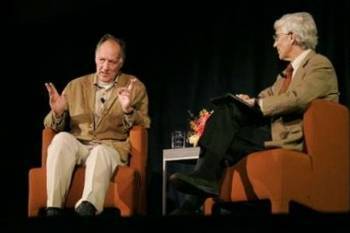
Werner Herzog, David Sterritt at SFIFF 2006
Last edited by Chris Knipp; 08-25-2014 at 11:53 PM.
-
SFIFF 2006: CONCLUDING WORDS

Isabelle Huppert in Gabrielle
THIS IS JUST A PARTIAL OVERVIEW; There's no way one person can see over two hundred films or "film events" in five weeks, the total time the press is allowed access to the SFIFF selections, and in real terms rating a big film festival is therefore strictly speaking impossible, but based on my random samplings I have some comments.
THE SFIFF'S NEW DIRECTOR is Graham Leggett, who's Scottish-born but a previous Bay Area resident and Stanford graduate. He was Director of Communications of the Film Society at Lincoln Center, where I met him at the NYFF press screenings. I like Graham's clarity and enthusiasm, and even his dour Scot side suggests he'll brook no nonsense, though he is great at hyping films and that's an important part of his job. He seems thoroughly energized and stoked about what he's doing here and well poised to liven things up over the next couple of years. His arrival is a hopeful note for the festival.
POLITICS AND PECKING ORDERS OF FESTIVALS is a topic still new to me; but it seems San Francisco might be at a disadvantage coming when it does. It ends just a couple weeks before Cannes begins. Big films are held for a first appearance at Cannes, which looks like being the beginning of the annual international festival cycle. Movie promoters may not want to dilute the big Cannes buzz by debuting their products at San Francisco -- or anywhere else that isn't a major festival venue.
THE SFIFF IS VIABLE AND WORTHWHILE because it plays to a large, sophisticated, and eager local audience. And there are a lot of filmmakers including some big guys who've escaped Hollywood to live up here, which increases the pool of celebs and talents at hand to participate.
THE SFIFF'S MOST DIRECT COMPETITION might be the new and smaller (by about a hundred films) Tribeca Film Festival, which comes in almost the same calendar spot and being in New York City has a powerhouse of talent to promote and run it. My guess is Tribeca may have had more new or offbeat stuff. Unlike the SFIFF, it naturally avoided any movies that had been screened previously in New York. Some of the best movies at SFIFF in my opinion that were not new to festivals, had been shown last year or this spring in New York.
LATIN AMERICA was confirmed for me as a great source of new filmmaking talent. Out of the 40 or so films/events of the SFIFF that I saw the most exciting new names were Alicia Scherson, whose Play is a witty, highly observant story of people wandering around in Santiago de Chile; and Ricardo Benet, a Mexican, whose News from Afar/Noticias lejanas is a haunting coming of age story that's also about marginalization. (And maybe globalization; but that word is being so overused in film talk it's becoming increasingly meaningless.) Each of these two Spanish-language movies provided the exhilaration of witnessing a brilliant, fully achieved first feature, and was a sign Latin America may be a hotbed of film creativity in years to come.
GREAT STUFF AT THE SFIFF I'D SEEN BEFORE: Sokurov's The Sun achieves greatness, Hou's Three Times is partly great, Chéreau's Gabrielle and Garrel's Regular Lovers are unforgettable: I had seen these four films at the NYFF. Two French selections were also repeats from New York, from the Rendez-Vous with French Cinema put on by the Film Society at Lincoln Center this March. Of these, I Saw Ben Barka Killed is somewhat dispensable (though worthy of attention if you're into modern French colonial history), but the second -- another story entirely -- Beauvois' Le Petit Lieutenant -- is an absolutely terrific cop flick, like many other cop flicks in every way except that it's more touching, more real, more felt and personal, and, for a French one, unusually sympathetic to cops. Tribeca didn't show any of these, because New Yorkers had already had a chance to see them.
DOCUMENTARIES I saw all seemed of value -- the politics-related Brazilian one Favela Rising and the more sweepingly political Venezuelan Dignity of the Nobodies. Shooting Under Fire and Beyond the Call are well-told stories about people doing good work in some of the world's major hot spots. Iraq in Fragments has wonderful images in its three separate segments -- though the director might have used editing and narration to make better use of them; it wasn't clear if it was Iraq that's in fragments, or the film. Other reportedly good documentaries at the festival: The Giant Buddhas, Workingman's Death, The Bridge. Funny and personal: Alan Berliner's Wide Awake.
COMPLETE GAPS IN THE PROGRAM? According to at least one source there were "grumblings that the festival's new regime neglects women directors and isn't looking hard enough for African and Middle Eastern films," but "few complaints about the continued strong selection of Asian entries." Indeed there weren't many African or Middle Eastern films, but maybe the programmers looked hard but couldn't find.
ASIAN SELECTIONS WERE DISAPPOINTING, though perhaps numerous enough. Tsai's Wayward Cloud is not the work of genius some think; in fact it may be the worst thing he's done and oscillates between being boring, shocking, and bizarre. Hou's aforementioned Three Times is brilliant and touching -- or one third of it is. Tsubokawa's sadly grainy and hard to follow Clouds of Yesterday is steeped in cinematic sense and may be a rough hint of fine work to come. Wakamatsu's Cycling Chronicles is little more than a troubling trifle. Kang's Sa-Kwa didn't quite make it. All About Love by Daniel Yu is slick schlock. Perhaps Love (which I didn't see) sounds like a hit or miss musical with great production values and big stars, if that's what you look for at a festival. Probably it isn't. Taking Father Home was amateurish and lame: not every rough hewn new generation mainland Chinese director is a Jia Zhang-ke. What were the judges thinking of in giving this their Skyye Prize? I guess they were rewarding financial need, more than talent. I also wonder why the festival awarded its Fipresci Prize to Half Nelson, starring Ryan Gosling, which didn't live up to expectations in either the acting or the screenwriting categories.
ANOTHER SHORT AREA WAS IRANIAN FILMS. While Tribeca boasted eight of them, all we got was the microcosm on an abandoned tanker, Iron Island, which was in the New Directors series at Lincoln Center a couple months before and was shown at an art house in lower Manhattan afterwards.
UNNECESSARY PREVIEWS SEEM A FEATURE OF FESTIVALS. Why do movies show up which are about to open in theaters? Oddly, audiences flock to see them, eager to be a few weeks ahead of the mob. Besides Half Nelson, Factotum, A Prairie Home Companion, and Art School Confidential all fell into this category. Tribeca, Cannes, etc. have things like this too. I guess it's part of the festival game, which isn't all about enriching our experience but also about promotion and reveling in novelty. At least San Francisco got a lavish Chinese musical as their opener and not what Cannes is starting with -- The Da Vinci Code.
LESSONS LEARNED? The obvious one: a sense that the world of cinema is rich today -- far richer than our cineplexes or art houses let us know; but an equally strong sense that the world isn't producing dozens of great new films every six months. No, that's just not about to happen. While not a festival junkie -- the type who's plotting the next one, and the next, and the next, to maintain the high of wall-to-wall new movies -- and the exhaustion of watching them -- I sure liked having the opportunity to see all this new stuff -- and to re-watch The Sun and Le Petit Lieutenant and Gabrielle. The latter gets limted release July 14. The other two, plus Hou's Three Times, have distributors but their release dates are unannounced. No distributor for Play or News from Afar. And that's too bad…but that's why there are festivals, and why we have to attend them.
 Posting Permissions
Posting Permissions
- You may not post new threads
- You may not post replies
- You may not post attachments
- You may not edit your posts
-
Forum Rules





 Reply With Quote
Reply With Quote











Bookmarks